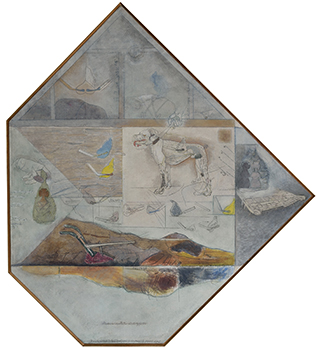Alexandru Chira
Retrospective
11 June–25 October 2015
Opening: Thursday, 11 June, 19h
The National Museum of Contemporary Art, Bucharest (MNAC)
MNAC DALLES
N. Bălcescu Blvd. 18
Bucharest
Curators: Mălina Ionescu, Călin Dan
Architecture: Attila Kim
Special thanks: Irina Chira, National Museum of Agriculture Slobozia, Art Museum Craiova, Roger Akoury, Marilena Istrătescu.
The first retrospective of Alexandru Chira’s work opens a program of monographic exhibitions through which MNAC aims to study and reconsider a series of Romanian contemporary artists who are relevant for a complete and coherent image of the historical, cultural and artistic context of the last five decades.
The conceptualism practiced by Alexandru Chira has a symbolist dimension unique in a cultural landscape where conceptualism is either abstract-geometrical, or belonging to the neo-orthodox philosophy, or dealing directly with subjects such as: the environment, society, politics, personal identity, the human body or the impact of technology. Chira’s is a magic symbolism grounded in the ritual function of objects, practices and places, on the one hand, and in the invocatory, magic function of drawing an act which shapes reality rather than describes it, on the other.
From his earlier works, in the ’70s, to the monumental land art project developed in his birthplace in Tăuşeni, the artist has always explored the functions and methods of drawing, a medium defined by the artist himself as the image of a usually tridimensional sign, and as the primary visual attribute, to which all other are subordinated.
De-signs towards the sky, for rain and rainbow, the great project from Tăuşeni—land art deeply rooted in ritual—is a monumental, tridimensional landscape drawing of these invocatory signs. The connection is intended on both a vertical axis—after the placing of the first elements it rained in that village for the first time in over 30 years—and radial: the symbolic elements which draw the ritual path are essential landmarks of the rural, archetypal world, of a personal home that becomes universal. Initiated in 1994 and still in progress, the monument from Tăuşeni was meant to be the beginning of a great unfinished project which aimed to prove that the marginality complex in the Romanian culture is unfounded, that acculturation can also start from Romania towards Europe and that the valorization of the specific traditions can turn any place into an important centre of cultural diffusion.
Sponsors: Crama Oprișor, Grup Transilvae



